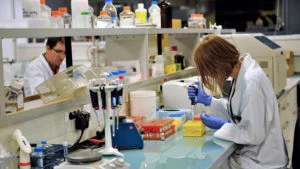Deadline: 29 October 2025
The European Commission is accepting submissions for the topic Generative-AI based Agents to Revolutionize Medical Diagnosis and Treatment of Cancer.
Specific Objectives
- Project proposals under this Challenge should focus on one (and only one) of the following diseases: breast cancer, cervical cancer, ovarian cancer, prostate cancer, lung cancer, brain cancer, stomach cancer or colorectal cancer.
- Each proposal should address both the following areas (at least one sub-objective from each of the areas):
- Area 1: Technological area
- GenAI-based tools for Integrating Multidimensional Multimodal health Data
- Investigate groundbreaking techniques and methodologies for developing GenAI algorithms that combine multidimensional (e.g. time dimension, space dimension) and multimodal data from various sources. These include multiple imaging modalities (e.g., MRI, CT, PET, X-ray), clinical data (e.g., electronic health records, lab results, structured and unstructured clinical data, pathology results, genetics and – omics data, videos, knowledge databases, and other resources). The goal is to provide a comprehensive view of the patient’s condition. The developed algorithms should be capable of producing unified and actionable datasets that can be exploited for the development of the AI tools described in Area 2 (clinical).
- Medical Data Augmentation
- Develop GenAI models based on groundbreaking techniques that are in the conceptual or initial experimental phase for medical data augmentation. These models should be capable of creating highly realistic synthetic medical data (images, genomics data, etc.) and generating complementary data from existing sources (for example producing synthetic CT images from MRI images), to support iterative cycles of model training.
- Medical Knowledge Representation and Integration
- Create an initial prototype GenAI model for medical knowledge representation and integration. This model should aim to develop a comprehensive and dynamic medical knowledge base, to identify discrete medical imaging features associated with demographic information and systemic conditions, to improve the interpretability of AI-based models and extract new knowledge not previously identifiable by experts without assistance.
- GenAI-based tools for Integrating Multidimensional Multimodal health Data
- Area 2: Clinical Area
- Predictive Diagnosis
- Develop an interactive autonomous agent capable of assessing the likelihood of a patient developing cancer by analysing their medical history, imaging data, and genetic information. The agent should provide personalised health risk predictions, enabling early detection and preventive measures.
- Enhance Personalized Treatment Selection
- Develop novel AI algorithms and architectures that leverages multidimensional and multimodal data integration, along with synthetic data generation, to predict the optimal treatment pathway for specific patient conditions, as well as to forecast disease progression and treatment efficacy providing a comprehensive view of patient care.
- Predictive Diagnosis
- Area 1: Technological area
Scope
- Imaging is a crucial component of cancer clinical protocols, providing detailed morphological, structural, metabolic, and functional information. However, harnessing the full potential of the data generated through medical imaging in clinical settings remains challenging. Clinicians often struggle to combine diverse and large-scale data into a comprehensive view of patient care, disease progression, and treatment efficacy. The inability to seamlessly integrate and interpret diverse data sources result in suboptimal patient outcomes and inefficiencies in the delivery of healthcare.
- The integration of traditional Artificial Intelligence (AI) with medical imaging can transform healthcare, but most existing applications are still in their infancy and must overcome a number of challenges to accelerate adoption. These include AI applications being confined to single data modalities, which restricts their overall effectiveness (Monomodal Application); inadequate and insufficient data training, leading to data scarcity and a lack of generalizability, making them less reliable across diverse patient populations, including with regard to gender-sensitivity; and the lack of AI model interpretability, as many AI systems function as “black boxes,” providing little insight into their decision-making processes. This lack of transparency limits trust in the systems and their usability in clinical settings.
- The goal of this Pathfinder Challenge is to create interactive GenAI autonomous agents and/or a combination of them (super-agent) that provide clinicians with a holistic end to end perspective of patient care, throughout the entire clinical pathway. These agents aim to enhance pattern identification, reduce inconsistencies and errors in diagnoses as well as improve cancer treatment. While the focus is on GenAI, they also encourage the integration of other advanced AI technologies, such as topological and geometric deep learning, neural fields, graph neural networks, etc., which can complement and enhance the robustness and effectiveness of GenAI-based solutions in addressing the challenges of cancer diagnosis and therapy.
- The Challenge will support early-stage groundbreaking research projects that will develop and validate novel approaches and concepts for integrating and interpreting multimodal medical imaging and health data. Additionally, it will involve generating reliable synthetic medical data, which will also be pooled to form a common database and used for the development of advanced algorithms.
Funding Information
- Budget (EUR) – Year 2025: 120 000 000
- Contributions: 500000 to 4000000
Eligibility Criteria
- Entities eligible to participate
- Any legal entity regardless of its place of establishment, including legal entities from non-associated third countries or international organisation (including international European research organisations) is eligible to participate (whether it is eligible for funding or not), provided that the conditions laid down in the Horizon Europe Regulation have been met together with any other conditions laid down in the specific call or topic.
- According to Article 2(16) of the HE Regulation, ‘Legal entity’ means any natural or legal person created and recognised as such under national law, EU law or international law, which has legal personality and which may, acting in its own name, exercise rights and be subject to obligations, or an entity without legal personality as referred to in point (c) of Article 200(2) of the Financial Regulation.
- To become a beneficiary, legal entities must be eligible for funding.
- To be eligible for funding, applicants must be established in one of the following countries:
- Member States of the European Union, including their outermost regions:
- Austria, Belgium, Bulgaria, Croatia, Cyprus, Czechia, Denmark, Estonia, Finland, France, Germany, Greece, Hungary, Ireland, Italy, Latvia, Lithuania, Luxembourg, Malta, Netherlands, Poland, Portugal, Romania, Slovakia, Slovenia, Spain, Sweden.
- the Overseas Countries and Territories (OCTs) linked to the Member States:
- Aruba (NL), Bonaire (NL), Curação (NL), French Polynesia (FR), French Southern and Antarctic Territories (FR), Greenland (DK), New Caledonia (FR), Saba (NL), Saint Barthélemy (FR), Sint Eustatius (NL), Sint Maarten (NL), St. Pierre and Miquelon (FR), Wallis and Futuna Islands (FR).
- countries associated to Horizon Europe – Pillar III:
- Albania, Armenia, Bosnia and Herzegovina, Faroe Islands, Georgia, Iceland, Israel, Kosovo, Moldova, Montenegro, North Macedonia, Norway, Serbia, Tunisia, Türkiye, Ukraine, United Kingdom.
- Member States of the European Union, including their outermost regions:
For more information, visit EC.





















